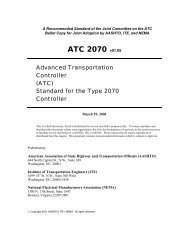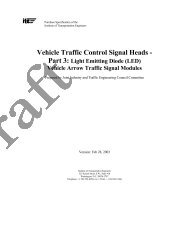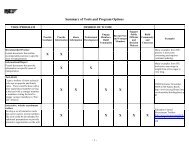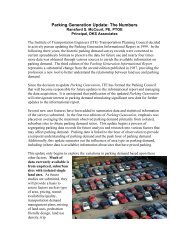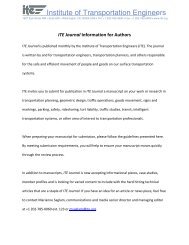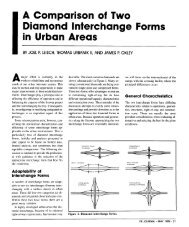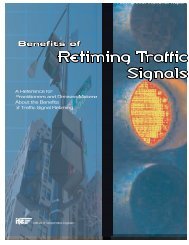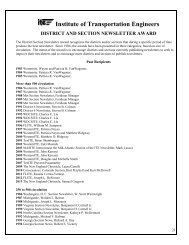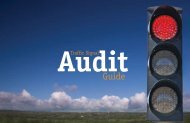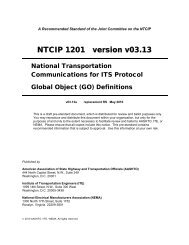Vehicle Traffic Control Signal Heads: - Institute of Transportation ...
Vehicle Traffic Control Signal Heads: - Institute of Transportation ...
Vehicle Traffic Control Signal Heads: - Institute of Transportation ...
Create successful ePaper yourself
Turn your PDF publications into a flip-book with our unique Google optimized e-Paper software.
ON interval as possible. If necessary, the ON<br />
interval may be extended to 10 seconds to permit<br />
completion <strong>of</strong> a measurement. The duty cycle<br />
between individual measurements, however,<br />
shall remain 12.5 percent, with a 5 second ON<br />
interval.<br />
6.4.4.7 Color uniformity: The average and nine<br />
individual sets <strong>of</strong> chromaticity values <strong>of</strong> each<br />
module under evaluation shall be plotted on the<br />
CIE 1931 Chromaticity Diagram (see Figure 1).<br />
6.4.4.8 Photometric and Colorimetric Tests<br />
Evaluation: At the conclusion <strong>of</strong> the photometric<br />
and colorimetric tests, the measurement data<br />
shall be compared to the applicable requirements<br />
<strong>of</strong> Sections 4.1 and 4.2.<br />
6.4.4.9 Acceptance/Rejection Criteria: The<br />
failure <strong>of</strong> a module to meet any <strong>of</strong> the following:<br />
the requirements for minimum maintained<br />
luminous intensity (4.1.1) or maximum<br />
permissible luminous intensity (4.1.2) under<br />
standard and high temperatures, the requirement<br />
for luminance uniformity (4.1.3), or the<br />
appropriate requirement for chromaticity (4.2)<br />
shall be considered a failure <strong>of</strong> the proposed<br />
design.<br />
6.4.5 Lens Tests: Following the photometric and<br />
colorimetric tests, the three modules shall be<br />
subjected to the following tests <strong>of</strong> the<br />
acceptability <strong>of</strong> the lens construction.<br />
6.4.5.1 UV Stabilization: Documentation shall<br />
be provided that certifies that the loss <strong>of</strong> direct<br />
transmission through the lens shall not cause the<br />
performance <strong>of</strong> the module to fall below the<br />
photometric requirements, or deviate from the<br />
colorimetric requirements <strong>of</strong> this specification<br />
after 60 months or greater as specified by the<br />
manufacturer, <strong>of</strong> service in accordance with<br />
3.3.1 and 3.3.4. Documentation shall be<br />
provided for hard-coat film (if used), tinting film<br />
or material (if used) and lens material.<br />
6.4.5.2 Lens Abrasion Test: Abrasion resistance<br />
testing <strong>of</strong> the module lens shall be performed as<br />
follows:<br />
a) A lens shall be mounted in the abrasion test<br />
fixture with the lens facing upwards.<br />
b) An abrading pad meeting the requirements in<br />
items c through f shall be cycled back and<br />
forth (one cycle) for 12 cycles at 10cm ±<br />
2cm per second over the whole surface <strong>of</strong><br />
the lens.<br />
c) The abrading pad shall be not less than<br />
2.5cm ± 0.1cm square, constructed <strong>of</strong> 0000<br />
steel wool and rubber, cemented to a rigid<br />
base shaped to the same contour as the lens.<br />
The “grain” <strong>of</strong> the pad shall be perpendicular<br />
to the direction <strong>of</strong> motion.<br />
d) The abrading pad support shall be equal in<br />
size to the pad and the center <strong>of</strong> the support<br />
surface shall be within ± 2mm <strong>of</strong> parallel to<br />
the lens surface.<br />
e) The density <strong>of</strong> the abrading pad shall be such<br />
that when the pad is mounted to its support<br />
and is resting unweighted on the lens, the<br />
base <strong>of</strong> the pad shall be no closer than<br />
3.2mm to the lens at its closest point.<br />
f) When mounted on its support and resting on<br />
the lens, the abrading pad shall be weighted<br />
such that a pad pressure <strong>of</strong> 14kPa ± 1kPa<br />
exists at the center and perpendicular to the<br />
face <strong>of</strong> the lens.<br />
g) A pivot shall be used if required to follow<br />
the contour <strong>of</strong> the lens.<br />
h) Unused steel wool shall be used for each<br />
test.<br />
6.4.5.3 Acceptance/Rejection Criteria: The<br />
photometric performance <strong>of</strong> a module following<br />
the lens abrasion test shall be 90 percent or more<br />
<strong>of</strong> the photometric performance <strong>of</strong> the same<br />
module measured prior to the lens abrasion test.<br />
A single point correlation as described in<br />
paragraph 6.4.4.4 may be used to determine the<br />
change in photometric performance. Failure <strong>of</strong><br />
any module to meet the requirement for<br />
photometric performance following the lens<br />
abrasion test shall be considered a failure <strong>of</strong> the<br />
proposed design.<br />
6.4.6 Electrical Tests: Three <strong>of</strong> the modules that<br />
were subjected to the environmental tests shall<br />
10



